Sailfin molly - Poecilia latipinna
Scientific name: Poecilia latipinna
Common name: Sailfin molly
Family: Poeciliidae
Usual size in fish tanks: 8 - 12 cm (3.15 - 4.72 inch)
014
Recommended pH range: 7.2 - 8.2
Recommended water hardness: 4 - 20°N (71.43 - 357.14ppm)
0°C 32°F30°C 86°F
Recommended temperature range: 20 - 30 °C (68 - 86°F)
The way how these fish reproduce: Pseudo-Livebearer
Where the species comes from: Central America
Temperament to its own species: peaceful
Temperament toward other fish species: peaceful
Usual place in the tank: Middle levels
General Information
The Sailfin Molly (Poecilia latipinna) is a tough, euryhaline livebearer native to the Atlantic and Gulf Coast drainages from North Carolina to Texas, south to Veracruz (Mexico). In nature it inhabits vegetated sloughs, ditches, marshes, creeks, and brackish estuaries, often within sight of the sea. Males develop the signature tall “sail” dorsal; females are larger but with a shorter dorsal base. Adults in aquaria commonly reach 8–12 cm (3–5″), with big females occasionally larger.
Food & Feeding
Omnivore with a strong grazing habit. Make the staple sinking/floating algae wafers and quality plant-rich flakes/granules; rotate small live or frozen items (daphnia, brine shrimp, bloodworms in moderation, chopped earthworms). Encourage natural aufwuchs/algae grazing on decor; this species uses both plant and animal matter efficiently. Feed modest portions 1–2× daily.
Water Chemistry, Salinity & Temperature
- Hard, alkaline water is best: aim for pH ~7.2–8.2 with measurable GH/KH. They struggle in very soft, acidic water long term.
- Salinity: tolerates freshwater to full-brackish (even hypersaline in nature). Optional low salinity (e.g., 2–5 ppt) can help in hard-water setups but is not mandatory if minerals are adequate.
- Temperature: cool–subtropical to warm: practical 20–30 °C (68–86 °F). Avoid sustained tropical heat without heavy aeration; high oxygen and low nitrate are important.
Sexing
Males have a gonopodium (modified anal fin) and an enlarged sail-like dorsal; females lack the gonopodium and have a shorter dorsal. Take care not to confuse P. latipinna with P. velifera (Yucatan molly): velifera males carry ~18–20 dorsal-fin rays vs. <15 in latipinna.
Breeding
True livebearer (ovoviviparous), not a “pseudo-livebearer.” Males fertilize internally; females can store sperm for multiple broods. Gestation is typically ~28–35 days depending on temperature and condition. Provide dense plants/floating cover for fry refuge. Start fry on finely crushed flakes, powdered fry food, or newly hatched brine shrimp. Keep a 1 male : 2–3 females ratio to diffuse male attention.
Tank Requirements & Layout
- Footprint: active cruisers; a long tank (90 cm/36″ ) helps, especially with groups and big males.
- Décor: hardy plants (e.g., vallisneria, hornwort), algae-friendly surfaces, open lanes for display; moderate flow, high oxygenation, and excellent filtration (they are sensitive to chronically high nitrate).
- Maintenance: regular water changes; stable minerals (GH/KH) are more important than adding “salt” by default.
Compatibility & Tank Mates
Generally peaceful, but males can be persistent courters. Keep in harems or larger groups with robust, similarly sized, non-nippy tank mates (e.g., peaceful livebearers, rainbowfish, larger rasboras). Avoid long-finned slow fish that invite chasing and very small fry-sized species that may be nibbled.
Behaviour & Usual Place in the Tank
Middle to upper levels, browsing surfaces and plant beds; often near the surface in calm, vegetated areas—mimicking their marsh/estuary origins. Provide open surface lanes and cover to reduce stress.
Size & Longevity
Plan for 8–12 cm (3–5″) commonly; large females can exceed this under spacious, rich conditions. Lifespan is typically 3–5 years with cool–subtropical temps, hard water, and low nitrate; males sometimes trend shorter due to constant displaying.
Short Description
Sailfin Molly (Poecilia latipinna) is a hardy, livebearing grazer from U.S. coastal fresh-to-brackish waters. Give it mineral-rich water (optionally slight brackish), strong aeration/filtration, lots of plant/algae grazing, and a harem grouping. Distinguish it from the larger P. velifera by fewer dorsal-fin rays and a smaller adult build.
Q&A
- Native where exactly? Atlantic–Gulf drainages from North Carolina to Texas, down to Veracruz, Mexico; common in coastal marshes and brackish ditches.
- Freshwater only? No—thrives from fresh to brackish (even hypersaline tolerance reported), so hardness/minerals matter more than adding salt by default.
- How warm? Best around 20–30 °C; can tolerate hot spells but needs high oxygen and clean water.
- Confused with velifera? Yes—velifera males have ~18–20 dorsal rays; latipinna has <15 (hybrids exist in the trade).
Pictures
Bought by aqua-fish.net from jjphoto.dk.
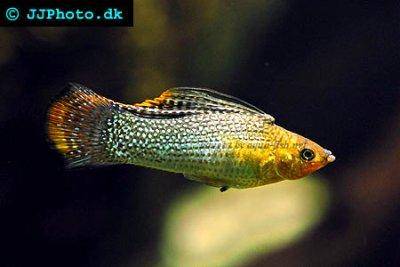













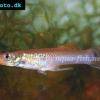 Pike
Pike 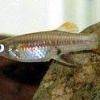 Biskop-tandkarpe
Biskop-tandkarpe 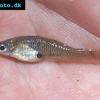 Mosquito
Mosquito 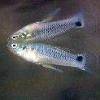 Twospot
Twospot 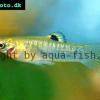 South
South 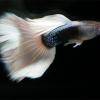 Guppy
Guppy  Short
Short 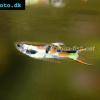 Endler’s
Endler’s 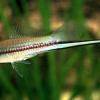 Swordtail
Swordtail 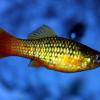 Platy
Platy 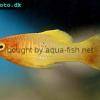 Variegated
Variegated